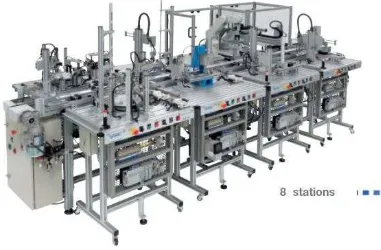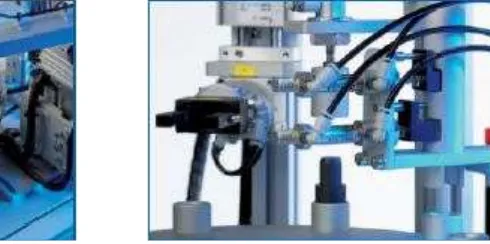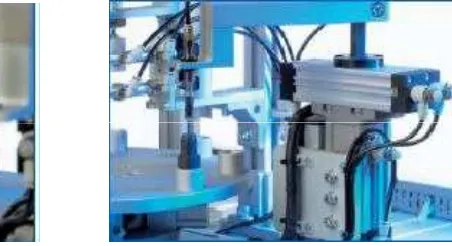i
UPGRADE FMS200: SHAFT SUPPLY MODULE THOUGH HUMAN MACHINE INTERFACE
LEE HO CHUNG
This report is submitted in partial fulfilment of the requirements for the award of Bachelor of Electronic Engineering (Industrial Electronics) with Honours
Faculty of Electronic and Computer Engineering Universiti Teknikal Malaysia Melaka
ii
UNIVERSTI TEKNIKAL MALAYSIA MELAKA
FAKULTI KEJURUTERAAN ELEKTRONIK DAN KEJURUTERAAN KOMPUTER
BORANG PENGESAHAN STATUS LAPORAN
PROJEK SARJANA MUDA II
Tajuk Projek : UPGRADE FMS200: SHAFT SUPPLY MODULE WITH HUMAN MACHINE INTERFACE
Sesi Pengajian : 0 9 / 1 0
Saya LEE HO CHUNG mengaku membenarkan Laporan Projek Sarjana Muda ini disimpan di Perpustakaan dengan syarat-syarat kegunaan seperti berikut:
1. Laporan adalah hakmilik Universiti Teknikal Malaysia Melaka.
2. Perpustakaan dibenarkan membuat salinan untuk tujuan pengajian sahaja.
3. Perpustakaan dibenarkan membuat salinan laporan ini sebagai bahan pertukaran antara institusi pengajian tinggi.
4. Sila tandakan ( √ ) :
SULIT*
*(Mengandungi maklumat yang berdarjah keselamatan atau kepentingan Malaysia seperti yang termaktub di dalam AKTA RAHSIA RASMI 1972)
TERHAD** **(Mengandungi maklumat terhad yang telah ditentukan oleh
organisasi/badan di mana penyelidikan dijalankan)
TIDAK TERHAD
Disahkan oleh:
_____________________________________________ ___________________________________
(TANDATANGAN PENULIS) (COP DAN TANDATANGAN PENYELIA)
iii
“I hereby declared this report is result of my own effort except for works that have been cited clearly in the references.”
Sinature : ………
Name : LEE HO CHUNG
iv
“I hereby declare that I have read this report and in my opinion this report is sufficient in terms of the scope and quality for the award of Bachelor of Electronic Engineering
(Industrial Electronics) with Honours.”
Signature : ………
Name : YUSMARNITA BINTI YUSOP
Date : 30 APRIL 2010
v
vi
ACKNOWLEGEMENT
I wish to express sincere appreciation to Universiti Teknikal Malaysia Melaka (UTeM) for giving me a chance to further my study on Bachelor of Degree in Industrial Electronics in Faculty of Electronic and Computer Engineering (FKEKK).
Despite of that, I would take this opportunity to express my profoundest gratitude and deepest regards to all those who gave me the possibility to successfully complete this PSM. I am deeply indebted to my Project Supervisor Puan Yusmarnita Binti Yusop and I wish to express a million thanks for her exemplary guidance, monitoring and constant encouragement throughout the development of the project.
vii
ABSTRACT
viii
ABSTRAK
ix
CONTENT
CHAPTER CONTENT PAGE
ACKNOWLEDGEMENT ABSTRACT
ABSTRAK CONTENT LIST OF TABLE LIST OF FIGURE
vi vii viii ix xii xiii
I INTRODUCTION
1.1 Introduction to FMS 200 system 1.2 Project Objective
1.3 Problem Statement 1.4 Scope of Work 1.5 Report Structure
1 3 4 4 5
II LITERATURE REVIEW
2.1 Introduction
2.1.1 Flexible Manufacturing System 200 2.1.2 Shaft Supply Module
2.2 Programmable Logic Controller (PLC) 2.2.1 PLC Block Diagram
2.2.2 Logic Instruction (Mnemonic)
2.2.3 Logic Instructions and Graphic Programming 2.3 Pneumatic
2.4 Pneumatic Cylinder
x
2.4.1 Operation 2.5 Pneumatic Valve 2.6 Pressure Gauge 2.7 Sensor
2.7.1 Capacitive Sensor 2.7.2 Inductive Sensor 2.7.3 Photoelectric Sensor 2.7.4 Potentiometer 2.7.5 Limit Switch 2.7.6 Reed Switch 2.8 Touch Screen
2.8.1 Resistive Touch Screen 2.8.2 Capacitive Touch Screen
2.8.3 Surface Acoustic Wave Touch Screen 2.8.4 Comparison between the Touch Screen
Technologies
2.9 CX-Programmer Software
19 20 23 23 24 26 28 31 32 33 34 34 35 36 36 37
III PROJECT METHODOLOGY
3.1 Project Planning 3.2 Literature Review
3.3 Study the Programming Language
3.4 Familiarize the FMS200: Shaft Selection Module 3.5 Troubleshooting
3.6 Finishing
39 41 42 43 44 41
IV RESULT AND ANALYSIS
4.1 Introduction of Result and Analysis
4.1.1 Ladder Diagram for type of shaft supply selection
4.1.2 Manual selection operation for each
xi
subsystem
4.1.3 Counter operation
4.2 Virtue Control Interface for Touch Screen 4.2.1 Main Control Interface
4.2.2 Main Menu Interface 4.2.3 Manual Selection Interface 4.2.4 Sensor Signal Interface 4.2.5 Output Signal Interface 4.2.6 Counter Output Interface 4.3 Discussion
71 71 72 73 74 75 76 77
V CONCLUSION AND SUGGESTIONS
5.1 Conclusion 5.2 Suggestion
78 79
REFERENCES APPENDIX
xii
LIST OF TABLE
NO TITLE PAGE
2.1 Differentials between PLC and PIC 13
2.2 Differentials between PLC and Conventional Controller 14
2.3 Mnemonic Code 16
2.4 Basic Instruction 17
2.5 Different between Pneumatic system and Hydraulic system 22
xiii
LIST OF FIGURE
NO TITLE PAGE
1.1 Block Diagram 2
2.1 FMS200 System 8
2.2 Index Plate 9
2.3 Feeding Module 9
2.4 Shaft Verification Module 10
2.5 Evacuation Module 10
2.6 Shaft Supply Module 11
2.7 PLC Block Diagram 17
2.8 Pneumatic Cylinder 19
2.9 Two Block Valve Diagram 21
2.10 Capacitive Sensor 24
2.11 Inductive Sensor 27
2.12 Photoelectric Sensor 28
2.13 Limit Switch 32
2.14 Reed Switch 33
3.1 Flow Chart Diagram 37
4.1 Ladder Diagram for Section 4 (Evacuation Process) 45
4.2 Ladder Diagram for Section 4 (Control path for Evacuation and Insertion)
47
4.3 Evacuation module carry the unwanted shaft from the rotary plate
49
4.4 Ladder Diagram for section 2 (Manual Selection) 57
xiv
4.6 Ladder Diagram for section 5 (Manual Selection) 65
4.7 Ladder Diagram for section 5 (Counter Data) 70
4.8 Main Control Interface 71
4.9 Main Menu Interface 72
4.10 Manual Selection Interface 73
4.11 Sensor Signal Interface Part 1 74
4.12 Sensor Signal Interface Part 2 74
4.13 Output Signal Interface Part 1 75
4.14 Output Signal Interface Part 2 75
CHAPTER I
INTRODUCTION
In this chapter, discusses regarding the introduction of FMS200 and describing the technique used to upgrade the shaft selection option by using CX-Programmer. The block diagram gave the general ideas on this project. In addition, objectives, problem statement of the project and the report structure is included as well.
1.1 Introduction to FMS 200 system
The purposes for this project are to upgrading the FMS200 with the touch screen control panel and enhance the system with ability to carry out material selection for the shaft. The conventional FMS200 system is controlled by using push button control panel which is inconvenient, lack of description about the operation of the system, high of cost maintenance, and having a lot of wiring. Besides that, the system is also lack of options for material shaft selection and will insert two kinds of the shafts into the assembly which contributes to the limitation of the performance of the system.
2
[image:16.612.112.534.269.403.2]to that, the CX- Designer software is also used to construct a front panel of virtual instrument. This front panel provides user interface, which is used to operate the system with multiple options such as start or stop operation, auto or manual operation, reset operation, and material selection option. In order to conduct interfacing between the PLC controller and the Touch screen control panel, an interface card is required to be installed to the system. Thus by upgrading the systems to a LCD touch screen control panel, it is now able eliminate the limitation for the conventional control panel and enhances the performance of the system.
Figure 1 : Block Diagram FMS 200: Shaft
Selection Module
PLC Controller
Interface LCD Touch
Panel
(CX-Designer)
Personal Computer
3
1.2 Project Objectives
There are several objectives that need to be achieved at the end of PSM. The objectives are listed as below:
i. To upgrade the system with LCD Touch Screen control panel which will increases flexibility of the system, reduces the wiring as well as the space requirement for the control panel.
ii. To enhance the system with ability to conduct reprogramming without consideration in hardware input.
iii. To upgrade the system with ability option to carry out material selection for shaft supply.
iv. To reduce the cost of maintenance of conventional push button control panel.
v. To provide a medium for the user to collect the information data regarding the performance of the system such as total output, total reject and etc.
vi. To enable the user to understanding the operation of the system with more easily way though manual selection.
4
1.3 Problem Statement
The FMS-204, which is the fourth station from the SMC-FMS-200 Training module, is mounted with the inductive and capacitive detector to detect the material of the shaft. However, it is unable to evacuate the undesired material from the rotation plate and hence, it will insert two different types of material shafts into the assembly. This is mainly due to the conventional control program lack of function to carry out a selection of shafts.
The conventional control panel consists of a start push button, stop push button, a reset push button, a selective switch to choose either continuous cycle or single cycle, and a push button meant for emergency stop. This control panel is lack of description about the operation of the system, and consist a lot of wiring.
1.4 Scope of Work
The scope of work in this project is started as given:
1. Familiarization on the FMS200 operation.
2. The PLC Programming Code is required to be modified in order to enable selection of material of shafts using CX-Programmer from CX-One Software. 3. NS-5 has been chosen as the LCD Touch screen to replace the conventional push
button control panel.
4. CX-Designer from CX-One software is used to create the human machine interface.
5
1.5 Report Structure
This thesis is a document report of the ideas generated, the theories and concepts applied, the activities performed and the final product of this project produced. The thesis consists of five chapters and each chapter is described as below:
Chapter 1, the introduction of FMS200 and describing the technique used to upgrade the shaft selection option by using CX- Programmer. The block diagram gave the general ideas on this project. In addition, objectives, problem statement of the project and the report structure is included as well.
Chapter 2, the background study of the project along with the literature review is performed and document about the theoretical concept applied in completing the project. Background studies on the PLC and operation method are stated throughout this project.
Chapter 3 is the introduction of the methodology for the project, design flow and construction of the project. Brief description is given about each procedure in the completion of the project.
Chapter 4 shows overall result and discussion of the result on current project. The developed of material selection of shaft on FMS200 shaft supply module, the created electric diagram block diagrams about the project are shown in order to strengthen the result.
CHAPTER II
LITERATURE REVIEW
In this chapter, discusses regarding the background study of the project along with the literature review is performed and documented about the theoretical concept applied in completing the project. Background studies on the PID controller and AC motor operation method are stated throughout this project.
2.1 Introduction
A flexible manufacturing system (FMS) is a manufacturing system in which there is some amount of flexibility that allows the system to react in the case of changes, whether predicted or unpredicted. This flexibility is generally considered to fall into two categories, which both contain numerous subcategories.
7
Most FMS systems comprise of three main systems. The work machines which are often automated CNC machine are connected by a material handling system to optimize parts flow and the central control computer which controls material movements and machine flow.
The main advantages of an FMS are its high flexibility in managing manufacturing resources like time and effort in order to manufacture a new product. The best application of an FMS is found in the production of small sets of products like those from a mass production.
An advantage of this system is:
i. Productivity increment due to automation.
ii. Preparation time for new products is shorter due to flexibility. iii. Saved labour cost, due to automation.
iv. Improved production quality, due to automation.
v. However, it is not always necessary that on increasing flexibility productivity also increases.
2.1.1 Flexible Manufacturing System 200
FMS is a flexible automation cell that allows the introduction of variations in the posts of which it is comprised towards adapting to the different requirements of companies and training centres. The system itself has eight stations involving a whole series of feeding, handling, verification and loading operation worked out using components from different technologies for smooth operations.
8
i. Body Feed-Positioning ii. Pick and Place Bearing
iii. Press Bearing in Hydraulically iv. Pick and Place Shaft and verify v. Pick and Place Cover
vi. Fit Screws
vii. Robot Screw Driving
viii. Unloading, storage and palletization of final assembly.
[image:22.612.159.540.357.607.2]Basically, the station can be easily extracted from the cell so that work can be done autonomously. Apart from that, each of the station carries out one part of the assembly process by using various technologies used in automated industry.
9
2.1.2 Shaft Supply Module
In the fourth workstation, the shaft is assembled on the product in process coming from the previous station. The two types of material of which they are manufactured which is aluminium and nylon increase the number of possible finished products that are assembled as well as increasing the didactic capacities of the FMS200.
The distribution around an index plate from the different operation uses an oscillating pusher cylinder and two stopper cylinders which work alternatively.
[image:23.612.111.293.279.403.2]
Figure 2.2: Index Plate Figure 2.3: Feeding Module
As the shafts remain stored in a gravity feeder, they are extracted and left in the first position of the revolving plate by using a steeper feeding system. Since the shaft is not symmetrical, it must therefore be positioned over the assembly in a specific position. In order to do so, the height is measured by a pneumatic cylinder together with a magnetic detector.
[image:23.612.250.495.281.403.2]10
[image:24.612.269.495.72.195.2]
Figure 2.4: Shaft Verification Module Figure 2.5: Evacuation Module
The following two station modules select the type of shafts which is either nylon or aluminium to be assembled on the product in process and rejects shafts that are manufactured of undesired materials. This function is done by a handling device with two shafts with a vacuum pad at the end and each shaft is composed of a dual rod cylinder which handles the shaft lifting movements and brings it to the evacuation ramp.
[image:24.612.107.291.73.194.2]


